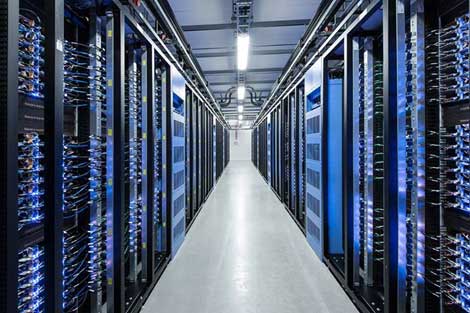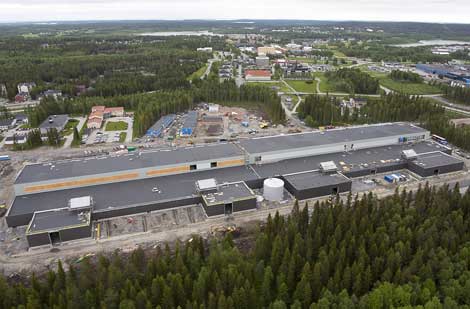
Some of the racks of Open Compute servers inside the new Facebook data center in Lulea, Sweden. The facility is Facebook's first data center outside the U.S. (Photo: Facebook).
Facebook has gone live in Lulea. The company's huge new data center in Sweden is now handling traffic from around the world, marking the first expansion of Facebook's infrastructure beyond the United States. The international presence reflects the changing nature of Facebook's users base. About 79 percent of the company's 1.11 billion users are outside the U.S. and Canada.
The location of the new data center takes advantage of the cool climate in Lulea, a seaside town of 45,000 on the edge of the Arctic Circle, at approximately the same latitude as Fairbanks, Alaska. That cool weather will allow Facebook to use outside air to cool the tens of thousands of servers that will occupy the new campus.
"As our systems come online for the first time, we are proud to say that this is likely to be one of the most efficient and sustainable data centers in the world," Facebook said. "All the equipment inside is powered by locally generated hydro-electric energy. Not only is it 100% renewable, but the supply is also so reliable that we have been able to reduce the number of backup generators required at the site by more than 70 percent. In addition to harnessing the power of water, we are using the chilly Nordic air to cool the thousands of servers that store your photos, videos, comments, and Likes. Any excess heat that is produced is used to keep our office warm."
Shift From Coal to Hydro
The use of hydro electricity is a change from the social network's first two company-built data centers in Oregon and North Carolina, which each relied upon utility power that originated primarily from coal. Facebook's power sourcing had been highlighted by the environmental group Greenpeace, which launched a lengthy campaign urging Facebook to "Unfriend Dirty Coal."
Inside the building, Facebook is using server and data center designs outlined in the Open Compute Project, which the company launched in February to release its custom designs for servers, power supplies and UPS units. That custom equipment helps Facebook maintain extremely high levels of energy efficiency, as measured by Power Usage Effectiveness (PUE), the leading measure of "green" data center operations.
"In early tests, Facebook's Luleå data centre is averaging a PUE in the region of 1.07," the company said. "As with our other data centres, we will soon be adding a real-time PUE monitor so everyone can see how we are performing on a minute-by-minute basis."
The new 27,000 square meter (290,000 square foot) data center will be the first on a multi-building campus in Luela, consistent with the company's practice at its previous sites in Prineville, Oregon and Forest City, North Carolina.
The nearby Lule River produces about 13.6 million megawatt hours of hydro-electric power, equal to 10 percent of Sweden's total demand for electricity. Officials in Lulea say the area has some of the cheapest power rates in all of Europe.
Fewer Generators
One novel feature of the new data center is that Facebook has reduced the number of backup generators by 70 percent. Facebook says the extraordinary reliability of the regional power grid serving the town of Lulea allows the company to use far fewer generators than in its U.S. facilities.
Local officials in Lulea say there has not been a single disruption in the area's high voltage lines since 1979. The city lies along the Lulea River, which hosts several of Sweden’s largest hydro-electric power stations. The power plants along the river generate twice as much electric power as the Hoover Dam.
"There are so many hydro plants connected to the regional grid that generators are unneeded," said Jay Park, Facebook's Director of Datacenter Engineering. "One of the regional grids has multiple hydro power plants."
Park says Facebook has configured its utility substations as a redundant "2N" system, with feeds from independent grids using different routes to the data center. One feed travels underground, while the other uses overhead utility poles.

An aerial view of the new Facebook data center in Lulea, Sweden, which is the company's first expansion of its infrastructure outside the U.S.





